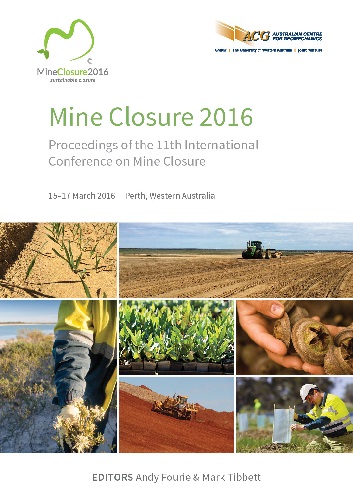Progressive rehabilitation — Martabe Gold Mine as a case study

|
Authors: Pearce, S; Orr, M; Grohs, K; Pearce, J |
DOI https://doi.org/10.36487/ACG_rep/1608_46_Pearce
Cite As:
Pearce, S, Orr, M, Grohs, K & Pearce, J 2016, 'Progressive rehabilitation — Martabe Gold Mine as a case study', in AB Fourie & M Tibbett (eds), Mine Closure 2016: Proceedings of the 11th International Conference on Mine Closure, Australian Centre for Geomechanics, Perth, pp. 619-634, https://doi.org/10.36487/ACG_rep/1608_46_Pearce
Abstract:
Progressive rehabilitation has been recognised by the mining industry as a key strategy for minimising mine closure costs and environmental risk, with the rehabilitation of potentially acid-forming waste rock being of particular interest due to the very large liabilities associated with sites where this risk has not been properly addressed. When properly implemented as an engineered solution, progressive rehabilitation of potentially acid-forming waste rock can provide an inherently more robust and lower risk rehabilitation strategy compared with the commonly-implemented alternative of an end-of-life waste dump covers. A case study is presented herein where progressive rehabilitation of potentially acid-forming waste rock has been successfully integrated with ongoing construction of the embankment of a tailings storage facility (TSF). The mine site in question, the Martabe Gold Mine in Indonesia, is thought to be unique in that construction of the TSF embankment at the site will require utilisation of almost all of the waste rock to be produced life of mine. The TSF embankment is therefore a fully integrated and engineered structure addressing both tailings and waste rock disposal requirements for the site. This approach offers a number of key benefits, including minimisation of both waste rock rehabilitation and tailings storage costs, and minimising the risk of long-term acid mine drainage. The progressive mine waste rehabilitation strategy adopted by G-Resources at the Martabe Gold Mine was designed taking into account the inherent properties of the waste rock materials, the run-of-mine waste rock schedule, and the engineering constraints required in order to construct a TSF embankment to exacting geotechnical standards. The strategy has required systematic implementation of outcomes reflective of industry leading practice, including: • Detailed waste characterisation studies. • Development of waste characterisation criteria. • Production of a life-of-mine waste schedule. • Selection of a waste sealing specification based on oxidation modelling. • Progressive implementation of selective waste placement and sealing. • Performance measurement to validate design and implementation. All key technical teams at the Martabe Gold Mine, including exploration, mine geology, mine planning, TSF construction and environment, have played an integral role in the implementation of this strategy, which can be described as an integrated waste management solution in which minimisation of mine closure risk is process that is carried out across the life of the mine.
Keywords: waste placement, progressive mine closure, oxygen diffusion
References:
Ball, BC, & Schjønning, P 2002, Methods of Soil Analysis, Part 4, Soil Science Society of America, pp. 1141–1158.
Harries, J 1997, ‘Acid mine drainage in Australia: Its extent and potential future liability’, Supervising Scientist Report 125, Supervising Scientist, Canberra, p. 94.
Lottermoser, BG 2003, Mine wastes: Characterization, treatment and environmental impacts, Springer-Verlag, Berlin, p. 277.
Lu, N 2001, ‘An analytical assessment on the impact of covers on the onset of air convection in mine wastes’, Numerical and Analytical Methods in Geomechanics, August 1999, pp. 347–364.
Pearce, SR 2014, ‘Beyond the PAF Cell’, in H Miller and L Preuss (eds), Proceedings of the Eighth Australian Workshop on Acid and Metalliferous Drainage, pp 97–110.
Pearce, SR 2015, ‘A risk-based approach using process flow diagrams for operational waste rock classification – case studies’, in AB Fourie and M Tibbett (eds), Proceedings of the Eleventh International Conference on Mine Closure, in press, Australian Centre for Geomechanics, Perth.
© Copyright 2025, Australian Centre for Geomechanics (ACG), The University of Western Australia. All rights reserved.
View copyright/legal information
Please direct any queries or error reports to repository-acg@uwa.edu.au
View copyright/legal information
Please direct any queries or error reports to repository-acg@uwa.edu.au